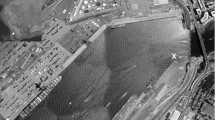Abstract.
This study measured SPLs of whistles of wild bottlenose dolphins (Tursiops truncatus) in the Moray Firth, Scotland, and estimated their active space, i.e. the distance at which another dolphin can perceive the whistle of a conspecific. Whistling dolphins were localized with a dispersed hydrophone array by comparing differences in the times of arrival of a whistle at different hydrophones. The mean source level for whistles was 158±0.6 dB re. 1 µPa. The maximum was 169 dB re. 1 µPa. The active space of these whistles was calculated taking into account transmission loss, ambient noise, the critical ratios and the auditory sensitivity of this species. The estimated radius of the active space of unmodulated whistles between 3.5 kHz and 10 kHz produced at maximum source level ranged from 20 km to 25 km in a habitat of 10 m depth and at sea state 0. At sea state 4 it ranged from 14 km to 22 km. For whistles of 12 kHz it dropped to 1.5–4 km. The results suggest that whistles can be used to maintain group cohesion over large distances but also that dolphins that researchers consider to belong to separate groups might be in acoustic contact.
Similar content being viewed by others
Author information
Authors and Affiliations
Additional information
Electronic Publication
Rights and permissions
About this article
Cite this article
Janik, V. Source levels and the estimated active space of bottlenose dolphin (Tursiops truncatus) whistles in the Moray Firth, Scotland. J Comp Physiol A 186, 673–680 (2000). https://doi.org/10.1007/s003590000120
Accepted:
Published:
Issue Date:
DOI: https://doi.org/10.1007/s003590000120




